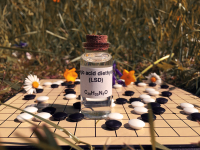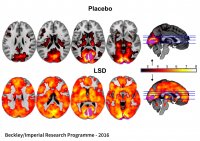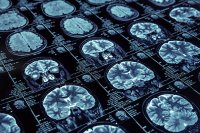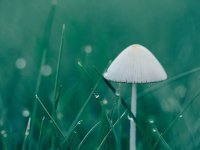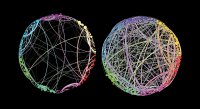
Amanda Feilding’s Talk at Horizons 2017

“Psychedelics are wondrous non-specific medicines of the future.
They can not only treat a wide range of mental and physical disorders, but can also facilitate transformation and inspiration which can leave an indelible mark. What amazing compounds. The food of the Gods indeed! They interact with the human brain in a way that fundamentally alters our mood and abilities.

Research is beginning to show how successfully they can treat a wide range of conditions including depression, anxiety, addictions of all kinds, PTSD, and OCD, among others.

There is also a growing body of clinical evidence supporting their potential to treat physical disorders as well.
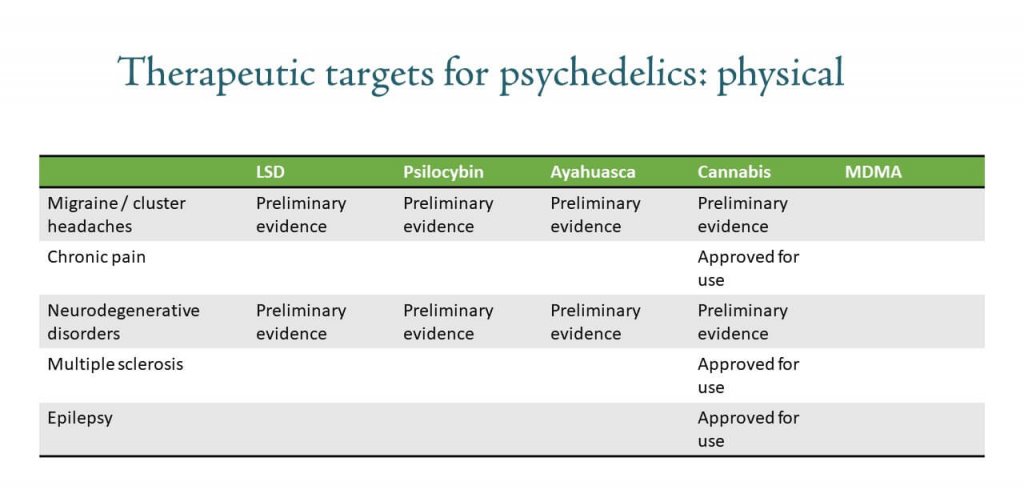
Our work is finally coming out of the shadows, and gaining widespread recognition, which, hopefully in time will make research easier, and most importantly, contribute to the re-scheduling of these compounds – cannabis, MDMA, and the psychedelics – so that doctors will be able to prescribe them, and clinics to provide them.


Using low doses of psychedelics – microdosing – to enhance wellbeing and creativity, has become very popular of late, and may indeed be the way we break down barriers, and make the psychedelic experience more accessible to people at large.

I have long been interested in the experience of taking regular doses of LSD, as this was an experience I learned the value of back in the 60s. I was introduced to LSD in 1965, and was extremely lucky to meet and partner with a scientist of exceptional insight the following year, Bart Huges.
He had recently developed two game-changing hypotheses:
One: About the changes in cerebral circulation underlying changes in consciousness, and the other: A mechanistic description of the ego.
I found these explanations life-changing, as they enabled me to live and work on LSD, and in my opinion to see much further and deeper than I would have been able to without them, and to be more creative and productive. I tested this hypothesis on the Go board, and found I won more games if I was on LSD and my opponent was not.

Using myself as my laboratory, I studied physiology, psychology, and philosophy and over the next 30 years did everything I could to find doctors and scientists interested in exploring these topics, and media personalities who would disseminate them to the wider world.
In those days, apart from occasions of the peak experience, my aim was to use the dose that hit that ‘sweet spot’, where vitality and creativity are enhanced, while leaving me in full control of my behaviour. I grew to love this state. It was comparable to what people are now doing with microdosing.
However, in those days, the majority of people were not on board with our vision of regular psychedelic use to enhance cognitive functioning. The message was more akin to Alan Watts – who said “when you get the message, hang up the phone”. We on the contrary saw psychedelics, as psychovitamins, or as tools to enhance creativity and productivity.
It is only now that people are coming round to this viewpoint.
I realised then, that the only way forward, through the ever- thickening fog of Prohibition, was with the very best science, and over the years I approached many scientists and doctors.

However, common sense and dedication was no competitor to the ‘Taboo’, which nearly always had the last laugh. It was like snakes and ladders. This continued for the better part of 30 years. It was a very exciting period, but I was amazed and saddened at the lack of substantial progress.

At the beginning of the 90s, brain-imaging technology began to emerge. I decided that I had better become a foundation, in order to get access to this new technology, and with it to explore the brain using the psychedelics as tools to alter consciousness, so that one could compare the normal state of consciousness with the enhanced one. To do this, in 1998 I founded the Beckley Foundation, which has been pioneering cutting-edge research into psychedelics ever since.

I invited some top scientists to be on my Advisory Board, starting with Albert Hofmann. Through the Beckley Foundation I established collaborations with leading scientists around the world. One such collaboration was with David Nutt, who, in 2005, I persuaded to join me in the scientific investigation of psychedelics. This collaboration evolved into the Beckley/Imperial Research Programme., which has carried out some breakthrough research.

Since then, most of the research carried out by the Beckley Foundation and other laboratories around the world, has been focused on one or two moderate to high doses of psychedelics – which can generate a ‘peak’ or ‘mystical’ experience, in which the most profound shifts in experience seem to occur.
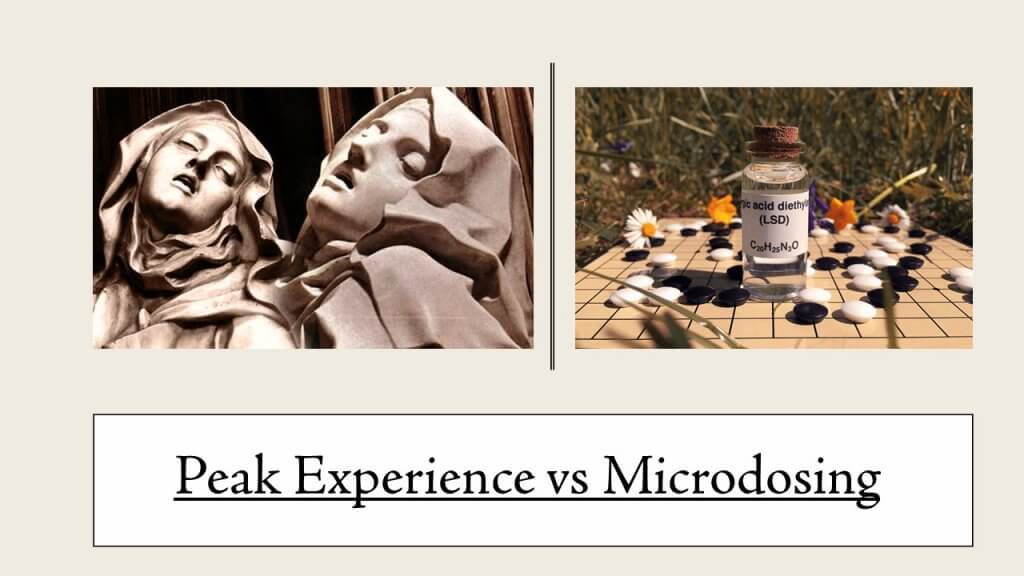
This state is characterised by:
- A sense of unity with all things
- Ego dissolution
- Transcendence of time and space
- A sense of insight into the ultimate nature of reality
- Feelings of ineffability and awe
- Profound positive emotions such as joy, connectivity, and love.
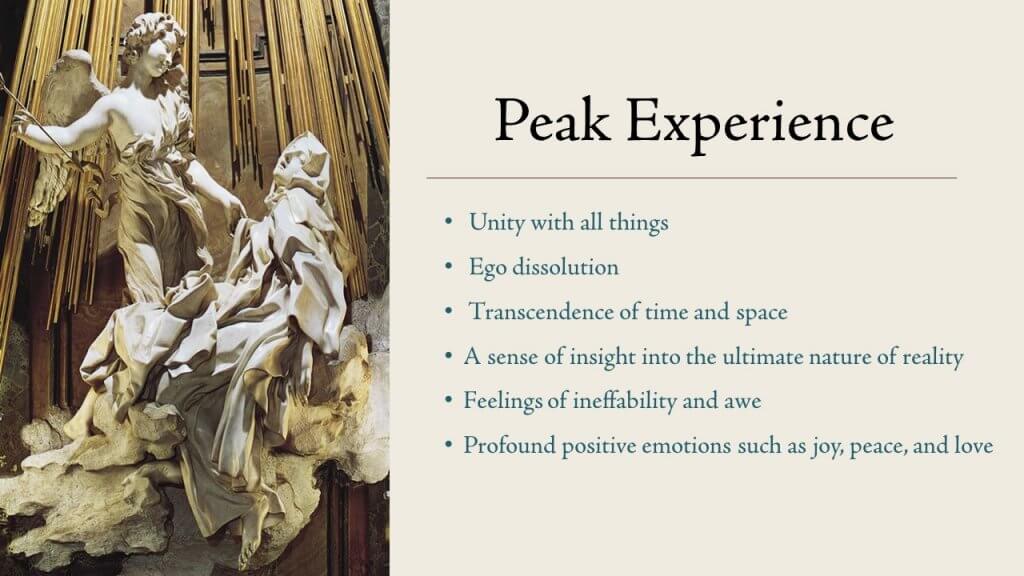
The peak experience is today being increasingly validated as a key component of psychedelic therapy.

However, I believe that the microdose, or maybe I should say, the ‘lower-dose’ that can be taken more regularly, should also have its place in psychedelic therapy, and as a ‘smart drug’ to improve well-being, mood and cognitive functioning.
The microdosing experience has an entirely different set of characteristic. It:
- Improves mood and vitality
- Enhances focus
- Boosts creativity
- Increases motivation and drive
all, importantly, while leaving the user in the driving seat.
Only recently has the world at large – led by Silicon Valley, and its desire to improve cognitive functioning – woken up to the possibilities of microdosing. But there has been no laboratory research conducted on it so far.
This is why I am currently preparing several microdosing studies at the Beckley Foundation. The first, as part of the Beckley/Imperial Programme, will use brain-imaging technology to investigate what is going on in the brain with very low doses of LSD.
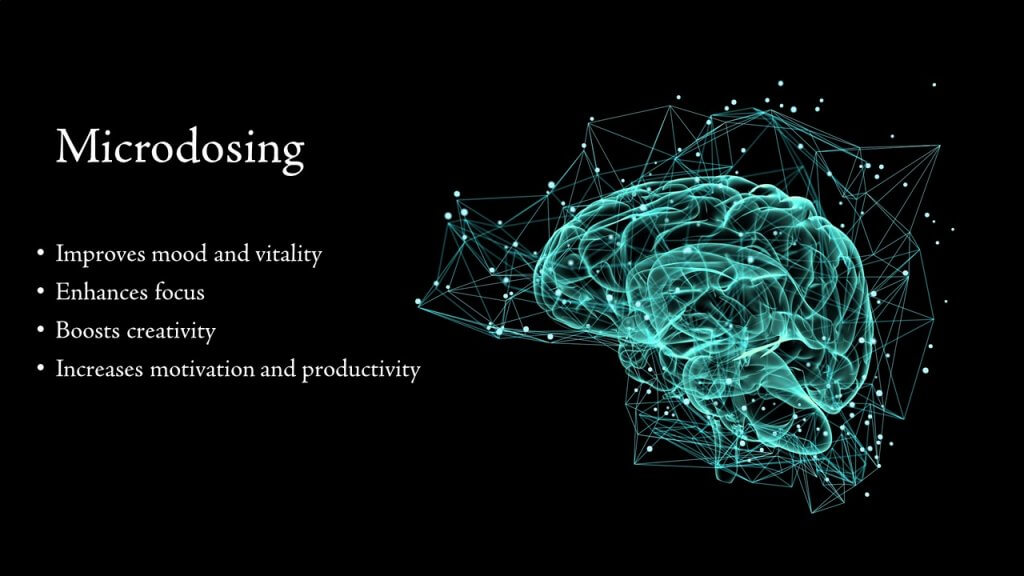
Technology has given us untold wealth in many areas but has not brought us happiness. We are currently in the midst of a global epidemic of mental illness. Can the careful use of psychedelics offer a new approach to psychiatry?

In the UK, 1 in 3 teenage girls suffers from an anxiety or depressive disorder. The number of teenage suicides has hit its highest rate, with more than 4 teenage suicides each week. It looks as though the epidemic is set to grow.
In the US rates are similar. According to the WHO, depression and anxiety are the leading causes of disability worldwide.
And once depression or anxiety sets in, psychiatry has limited tools to deal with it. Up to 30% of patients are unresponsive to antidepressant treatment, and 15% of people with treatment-resistant depression commit suicide.
Instead of uncovering the underlying causes of depression and anxiety, modern medicine prescribes medications that suppress the symptoms, rather than curing them, and which create their own problems.
However, psychedelics, which exhibited so much promise during the 50s and 60s for psychological disorders, appear to reduce the symptoms of many mental-health disorders, and remarkably the results are sustained for long periods afterwards. Psychedelics, unlike conventional psychiatric medicines, produce their effects with just one or two doses, which could be maintained with an occasional booster when necessary, if the psychedelics were to become regulated medicines.
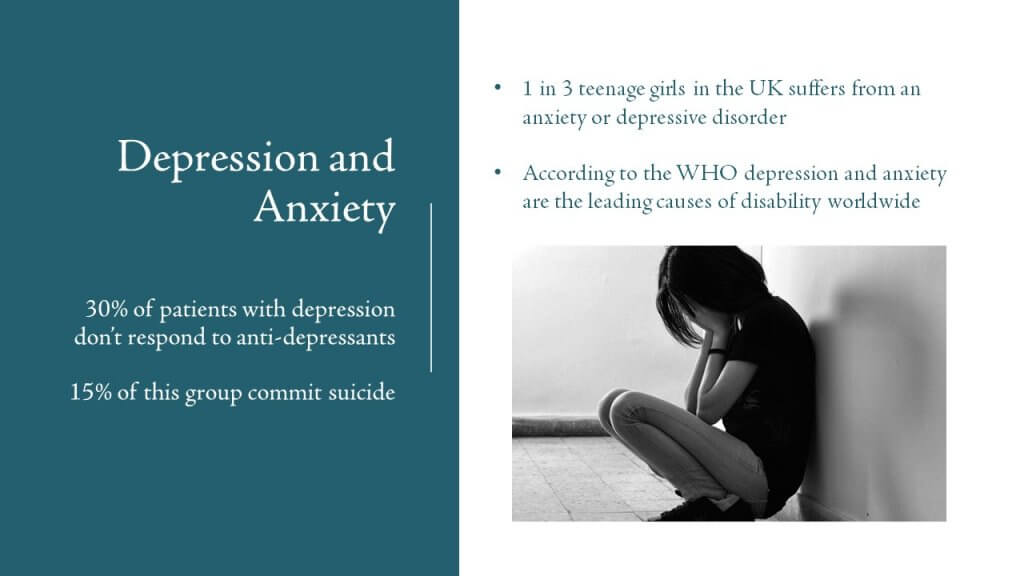
The Beckley/Imperial Research Programme carried out the first study to investigate the efficacy of psilocybin for treatment-resistant depression, the results of which were published last year in the Lancet. 67% of participants were depression-free after one week, and 42% remained in remission three months later. Our recent research has shown that this improvement is sustained for 6 months.
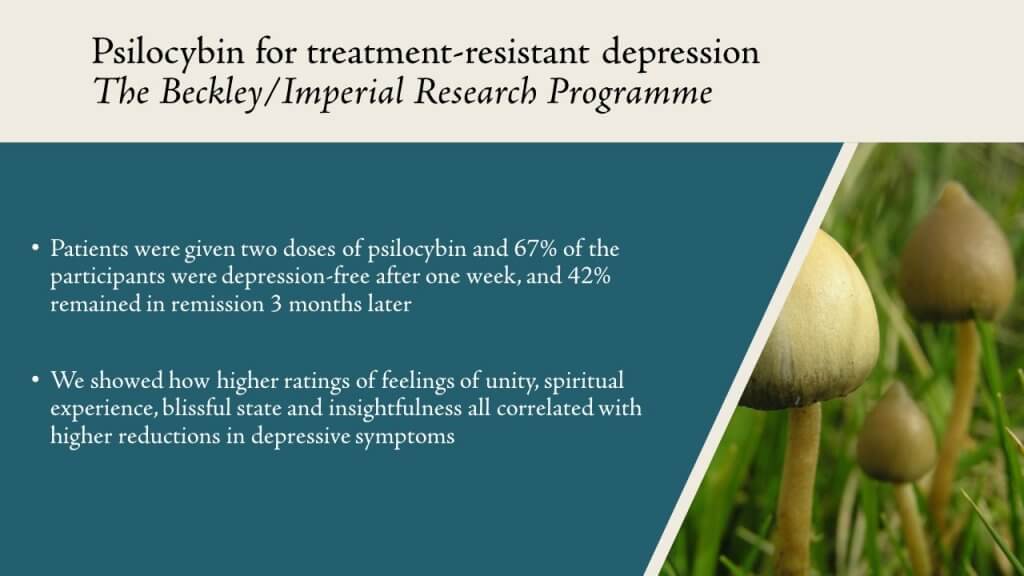
We showed how higher ratings of feelings of unity, spiritual experience, blissful state and insightfulness, all correlated with higher reductions in depressive symptoms.
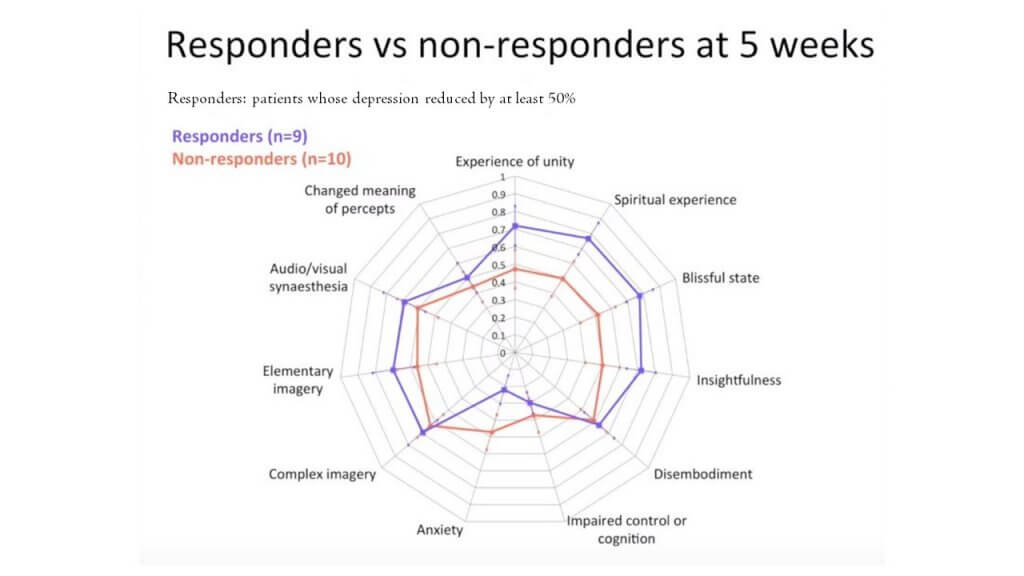
A study investigating psilocybin for nicotine cessation carried out at Johns Hopkins, that we sponsored from the beginning, has also shown that the greater the mystical-type experience, the greater the benefits.
In this study:
- Participants received 2 doses of psilocybin (with an optional 3rd)
- At 6 months, 80% were smoking-abstinent; and 67% at 12 months
- A remarkable 86.7% of participants rated their psilocybin experiences among the 5 most personally-meaningful, and spiritually-significant experiences, of their lives
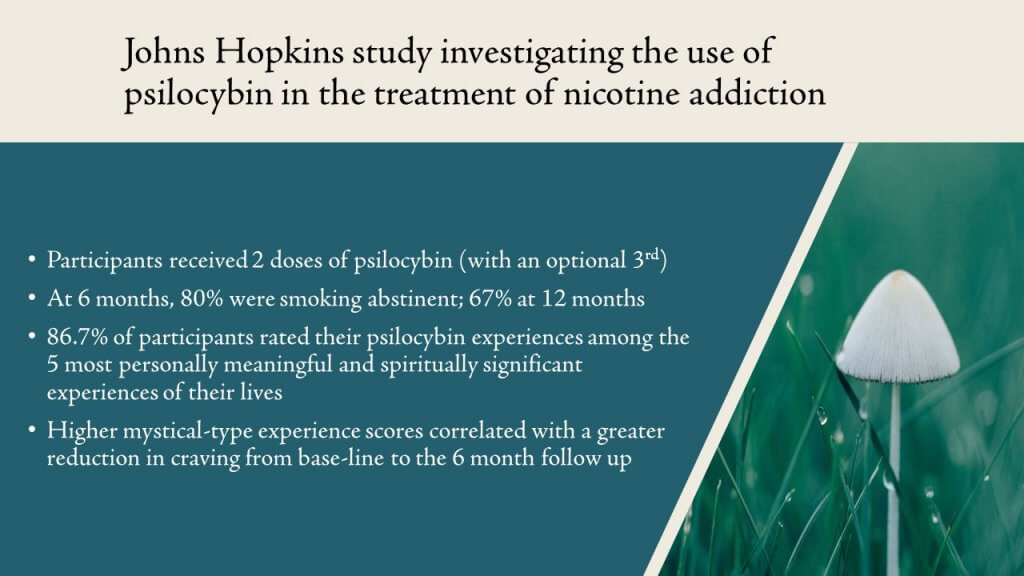
- Higher mystical –type experience scores, correlated with a greater reduction in craving from base-line to the 6 month follow up
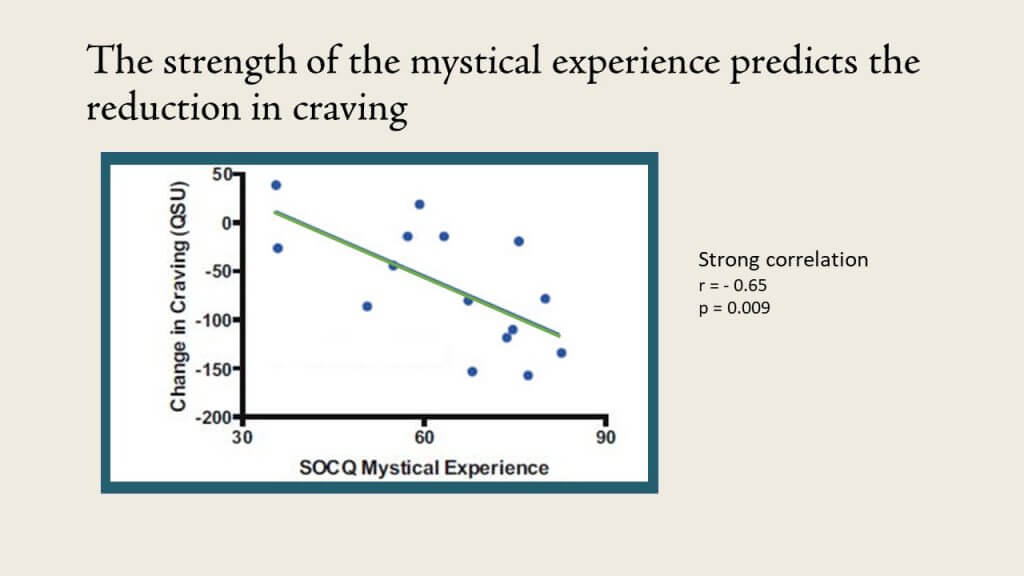
The Johns Hopkins and NYU studies looking at psilocybin as a treatment for the anxiety created by the diagnosis of terminal illness, found that the greater the mystical experience, the greater the reductions in depression and anxiety among participants.
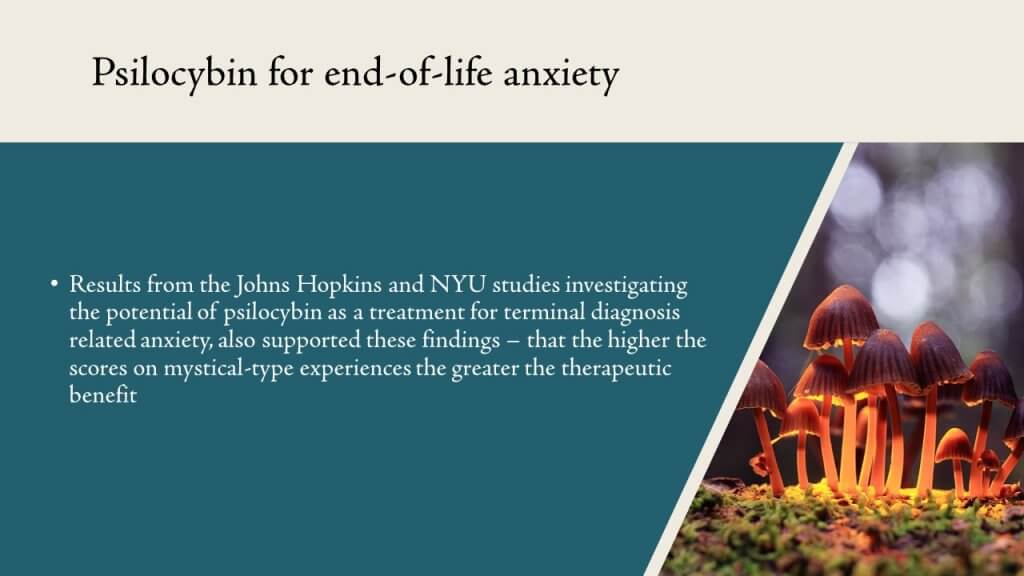
The Peak experience appears to reboot the brain, breaking fixed patterns of thought and behaviour, increasing neuroplasticity, and enabling one to transform maladaptive patterns of behaviour, such as those underlying depression, addiction, OCD and PTSD.
For those struggling with depression and anxiety, the experience may enhance their sense of self-worth and interpersonal connectedness, decreasing feelings of alienation and estrangement.
For the cancer patient facing death, the mystical experience can help the patient to overcome their fear of dying, and to find a sense of peace with their fate.
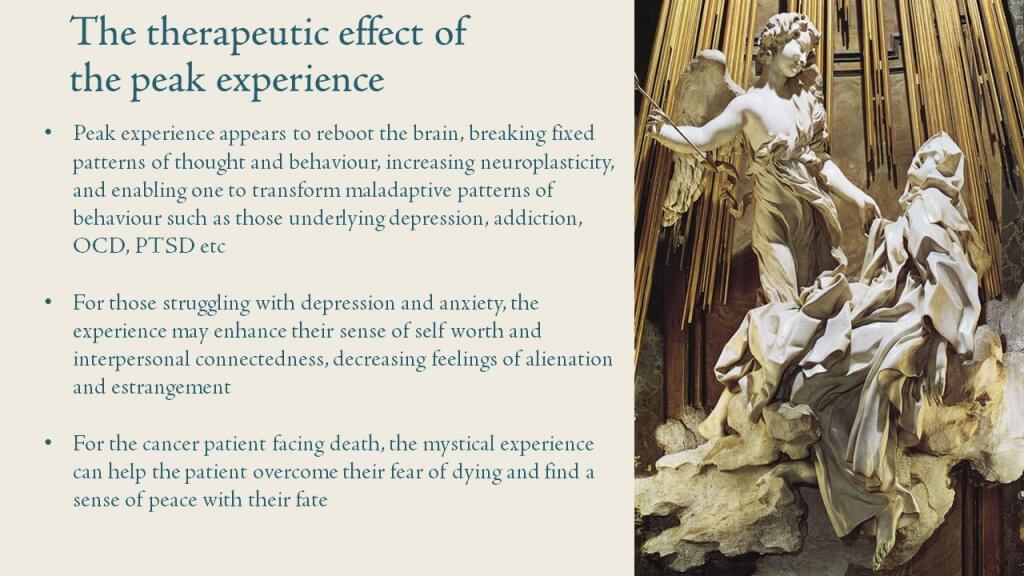
Brain-imaging can help us to understand the neural underpinnings of these experiences, and to explain why they may be providing such relief in a wide variety of conditions.
Our psychedelic research at the Beckley/Imperial Research Programme has focused on the disruption of the Default Mode Network (DMN), a high level cortical network, which underlies the autobiographical sense of self, and in many ways represents the seat of the ego, and also acts as the door-keeper of consciousness. It has been observed that the 2 main hub-centres of the Default Mode Network, the medial pre-frontal cortex and the posterior cingulate cortex, are hyper-active in sufferers from depression and addiction. It is as if the negative ruminations have got fixated.
The feeling of ‘ego-dissolution’ features in participant reports of their experiences, and correspondingly we have seen the Default Mode Network ‘disintegrate’ and become much less ordered and cohesive, with a reduction of its blood-supply. Simultaneously, we have seen increased communication between the individual hubs within the DMN and other networks in the brain.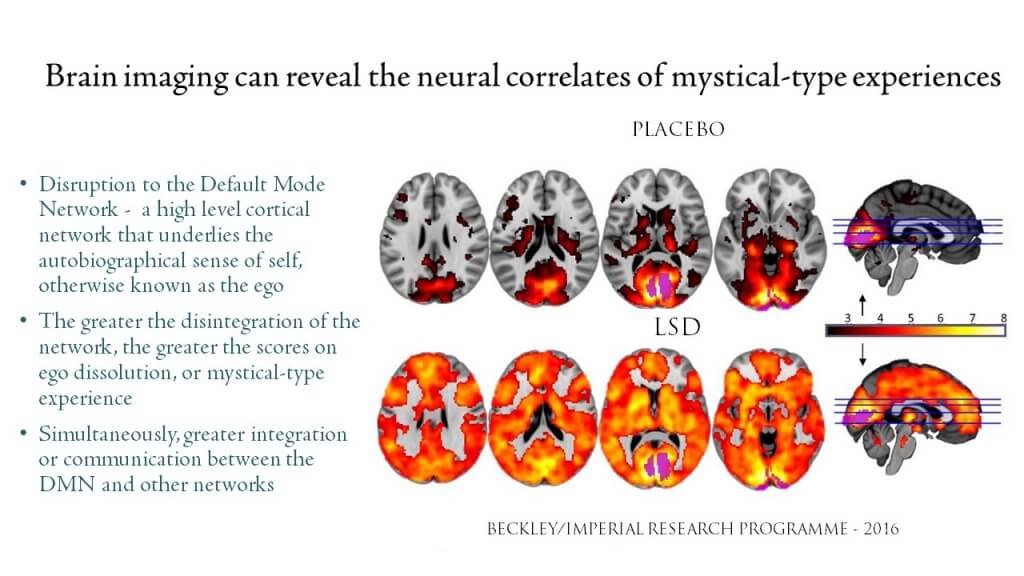
However, I don’t think the DMN is the only network we should be looking at. The self isn’t a unitary phenomenon: there are many different selves jostling within our brain, and many different ways to characterise the experience of selfhood.
Here I would like to briefly look at 3 primary senses of self, which I will call the EGO, EXECUTIVE and CORE self.
One can compare these three selves to Freud’s ego, superego, and id.
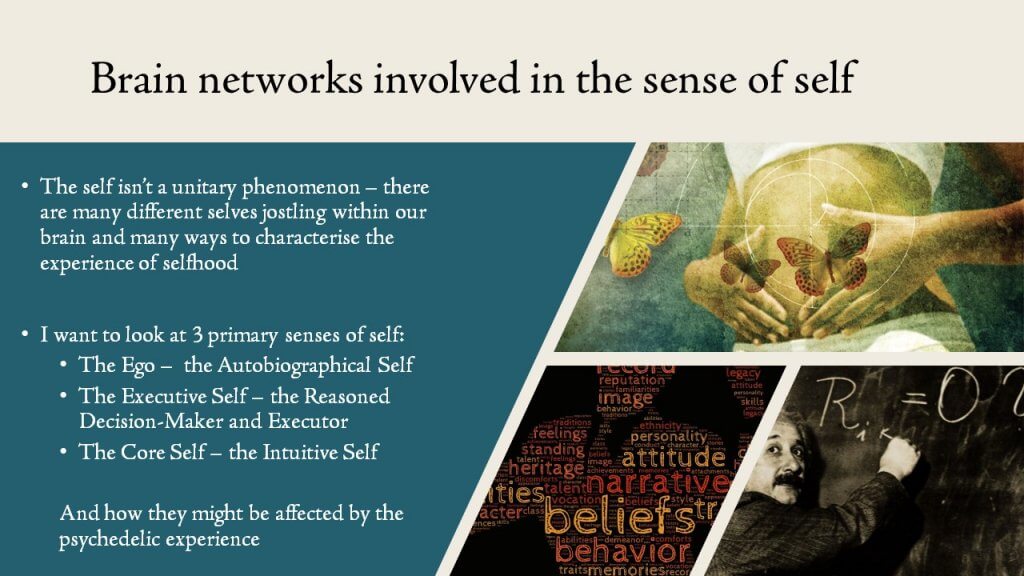
The Ego, or the Autobiographical Self, is the one that’s become most familiar to psychedelic researchers. It’s our sense of ourselves as an entity, that ties together our memories of who we are, and our understanding of who we’ll be in the future, and thus our ability to plan ahead in the long term.
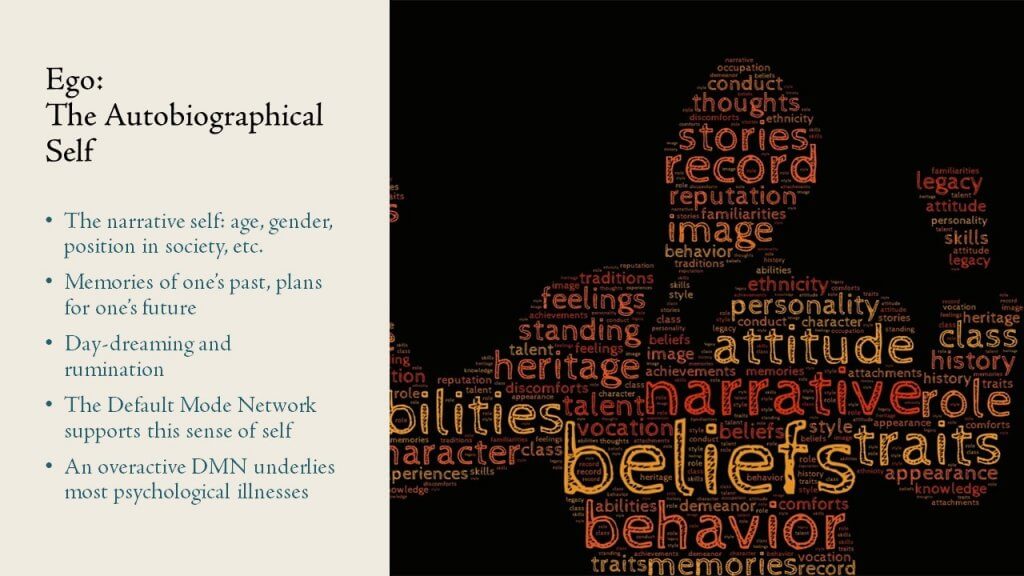
The Default Mode Network supports this sense of self.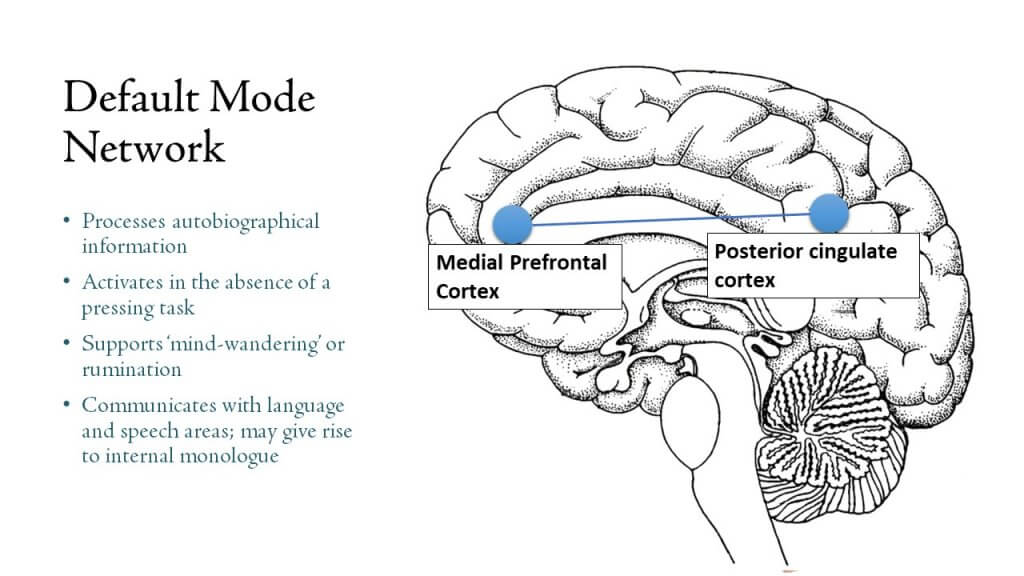
Our Executive Self is our rational decision maker. This self, is supported by the Central Executive Network (CEN), a number of high-level cortical regions, which can summon information and hold it in working memory; direct attention and maintain focus on one task; weigh up an issue, and make a decision; and initiate actions.
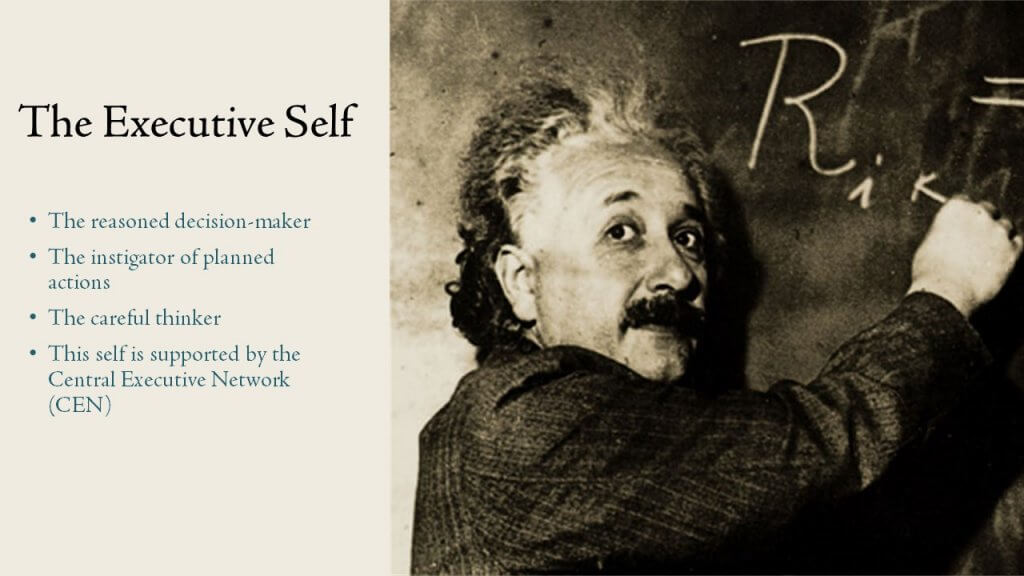
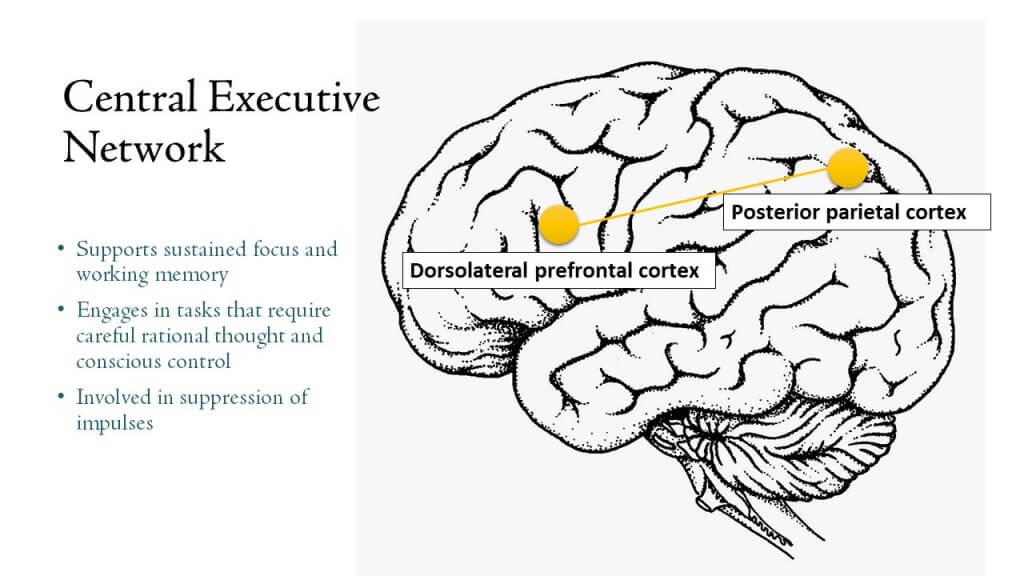 Finally, we have a more fundamental or intuitive sense of self; a self that is concerned with our present-moment awareness. This sense of selfhood is represented within the insula, a region that sits between the limbic system and the prefrontal cortex, and seems to bridge the gap between the emotional, instinct-driven limbic system, and the rational neocortex.
Finally, we have a more fundamental or intuitive sense of self; a self that is concerned with our present-moment awareness. This sense of selfhood is represented within the insula, a region that sits between the limbic system and the prefrontal cortex, and seems to bridge the gap between the emotional, instinct-driven limbic system, and the rational neocortex.
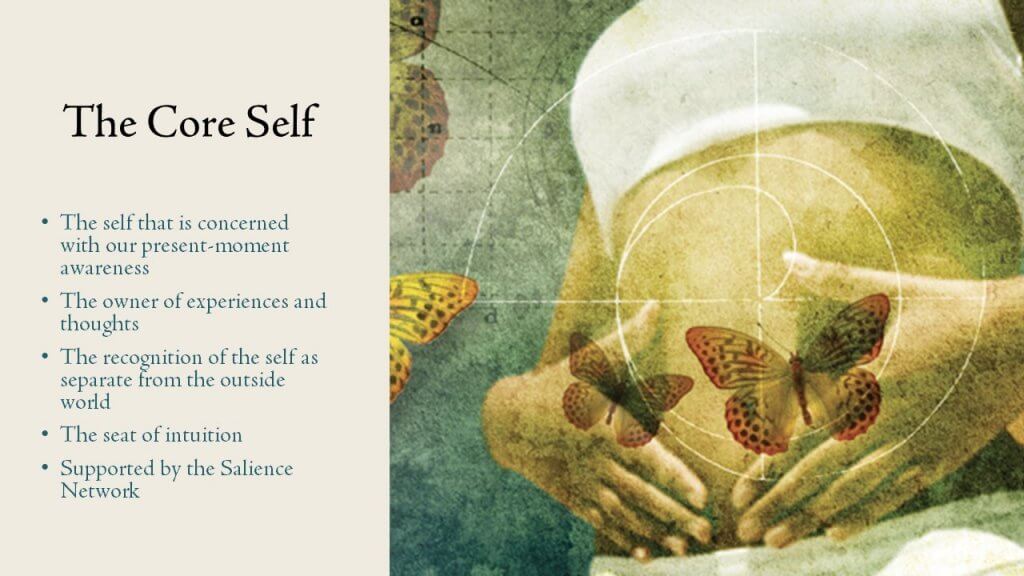
The insula is implicated in a wide range of conditions and behaviours, from orgasm, to cigarette-craving and maternal love, to decision-making and sudden insight, and probably consciousness itself.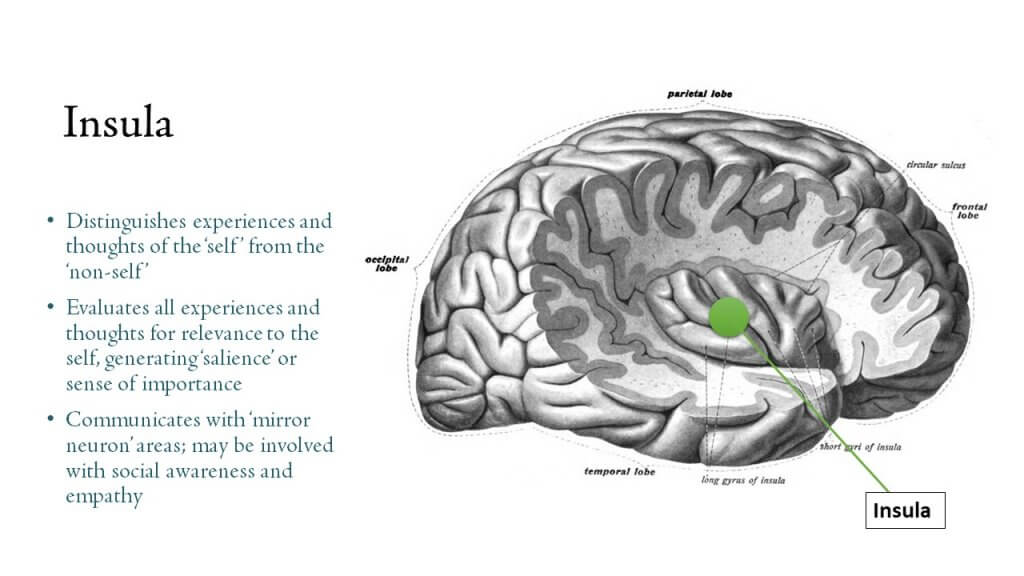
The insula is a key node of the Salience Network, another high-level network that has significant control over the brain. Its other main node, the Anterior Cingulate Cortex, is involved with analysing information from all over the brain to work out what is the most important, and then drawing focus to it – making it salient, in other words. It draws heavily on our emotional centres to make these judgements, and is involved in our sense of intuition.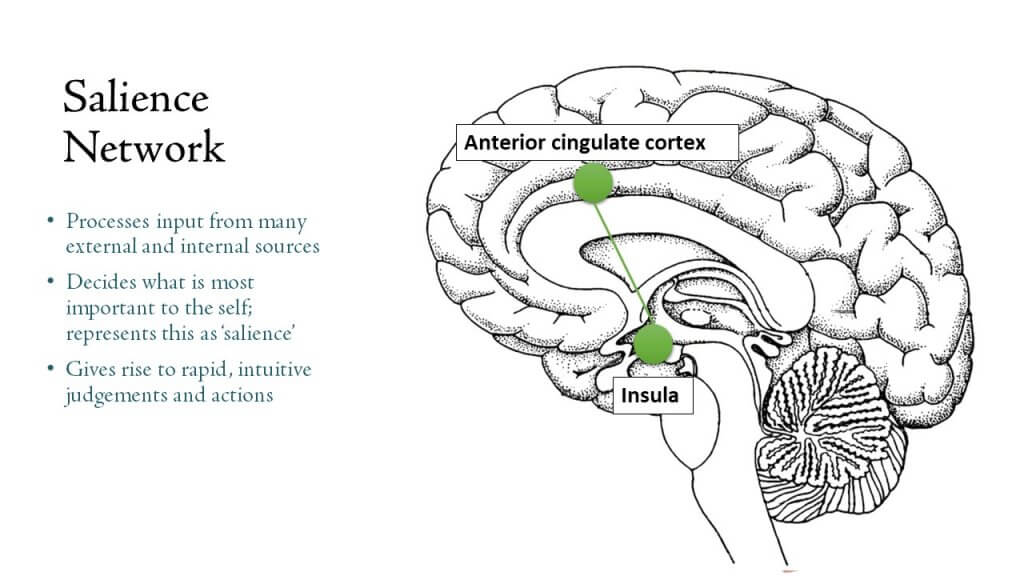
These three networks – the Default Mode Network, the Central Executive Network and the Salience Network– all exert control over the mind. Often, they work in tandem. At other times, they seem to ‘compete’. The sensation of being torn in different directions while making a decision, for example, may be the result of these different networks coming to different conclusions about the best course of action.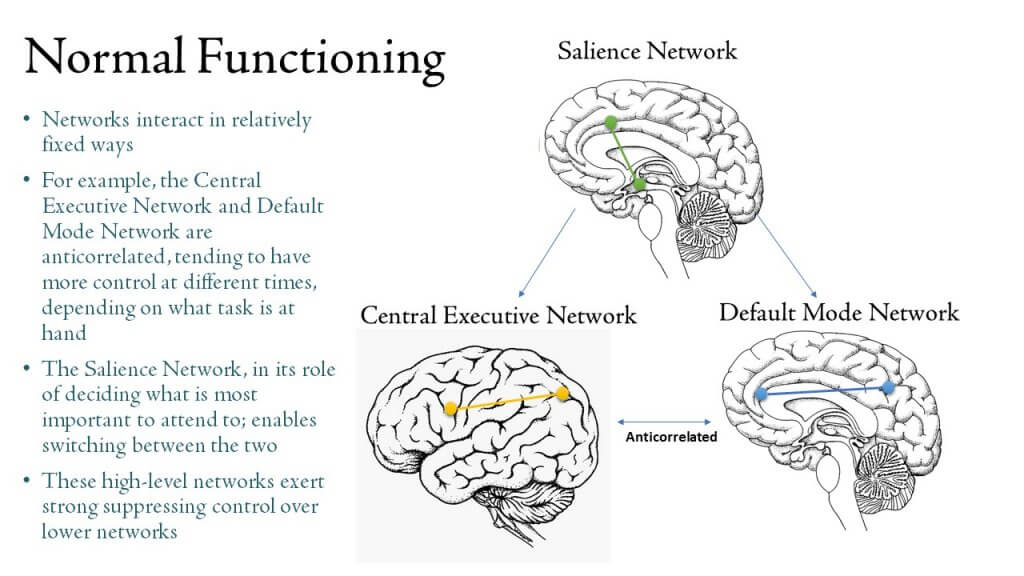
Psychedelics, we have discovered, cause a disruption in normal network-functioning.
Networks disintegrate, meaning that the hub regions within a network stop communicating as closely.
Networks also desegregate, meaning that their regions start communicating more closely with other regions outside the network.
We’ve conducted considerable research investigating how this affects the Default Mode Network, but, of course it could equally apply to other networks too.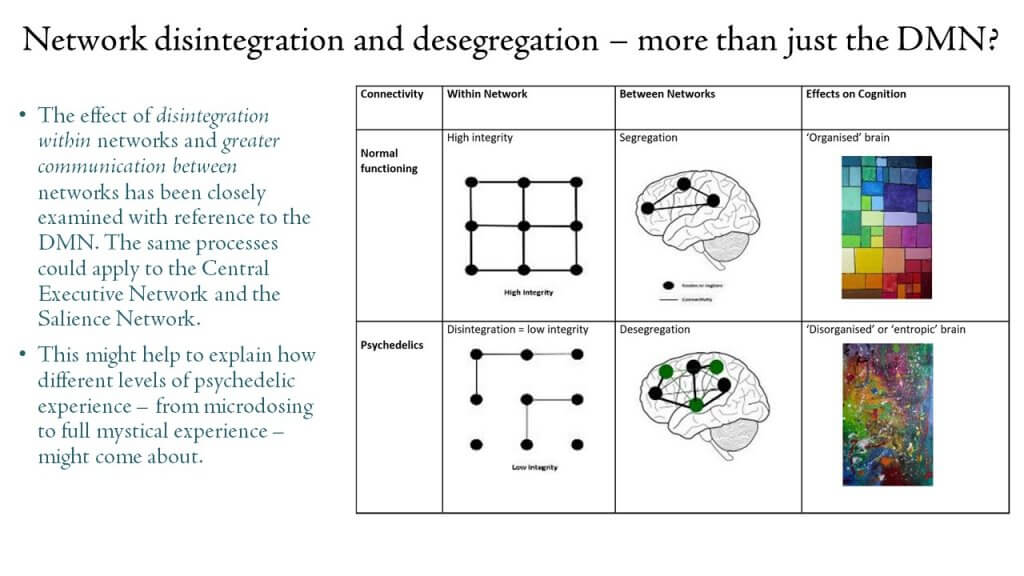
This could explain both the mystical and the microdosing experiences:
- Under the influence of psychedelics, the self-representing networks desegregate and communicate with other networks much more. Our representation of our self becomes more fluid and chaotic.
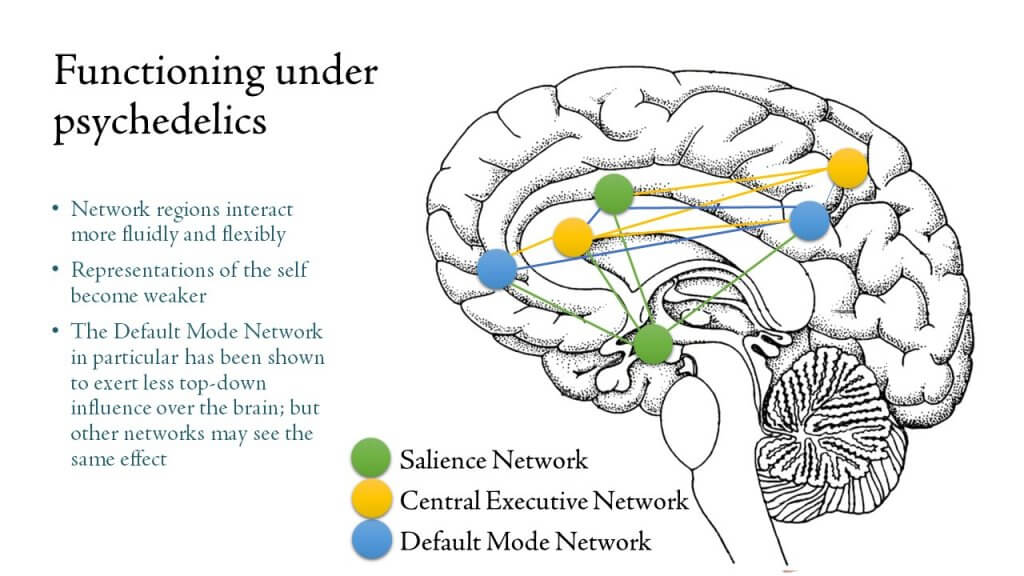
- With the high or median dose: other networks, such as the salience network, may increase its influence on the experience, by increasing the salience of usually unimportant things.
- Take for example Aldous Huxley’s description of flowers during his first trip “I was not looking now at an unusual flower arrangement. I was seeing what Adam had seen on the morning of his creation – the miracle, moment by moment, of naked existence.”
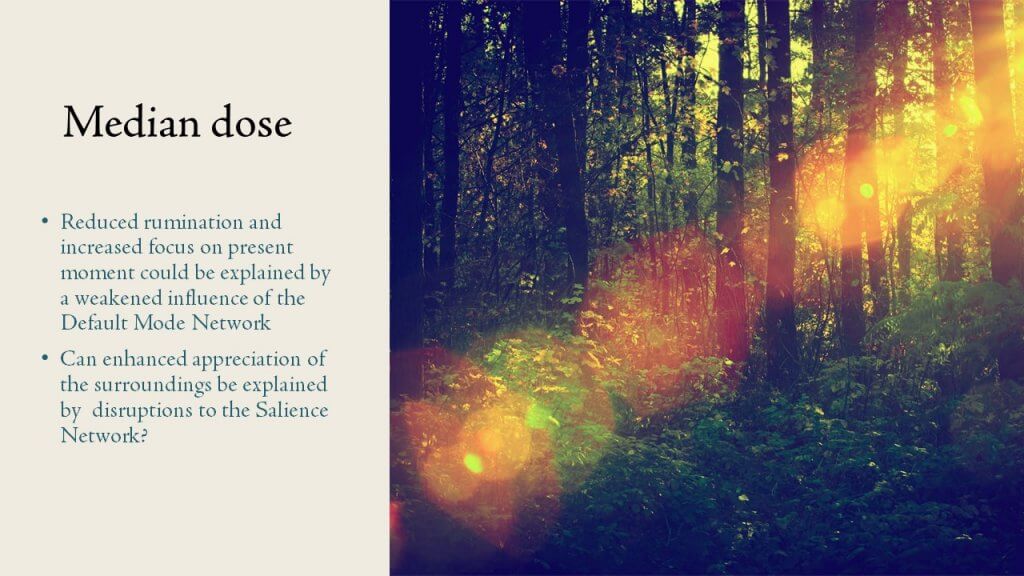
- Reduction in Default Mode Network-coherence could also be important for microdosing, giving rise to the ‘flow’ state, where you lose yourself in the task you are performing, becoming one with the flow.
- A recent study has shown that increased communication between the Default Mode Network and the Central Executive Network leads to enhanced
- Mild desegregation in network function, as brought about by the microdose, could allow more novel problem-solving pathways to be opened up, involving more communication between brain-networks which do not normally communicate with each other, leading to enhanced insight and intuition. I am hoping to explore this in our microdosing study, where I have proposed that we use the ancient game of Go as the task to investigate creativity and intuitive pattern-recognition.
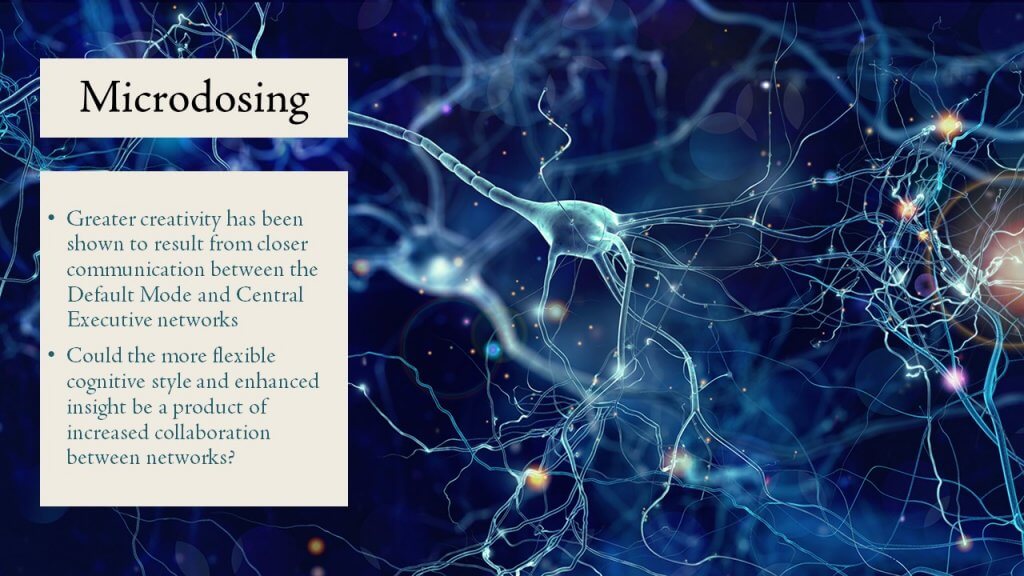
- Aspects of the mystical experience could also be explained by a profound disruption of the Salience Network:
- Ego-dissolution, or non-duality: resulting from the failure to differentiate between self and the outside world
- Divinity: the sense of communicating with a greater entity, due to misinterpreting one’s own thoughts as coming from the outside
- Transcendence: the sense that everything has some ultimate significance or meaning, caused by everything gaining increased salience
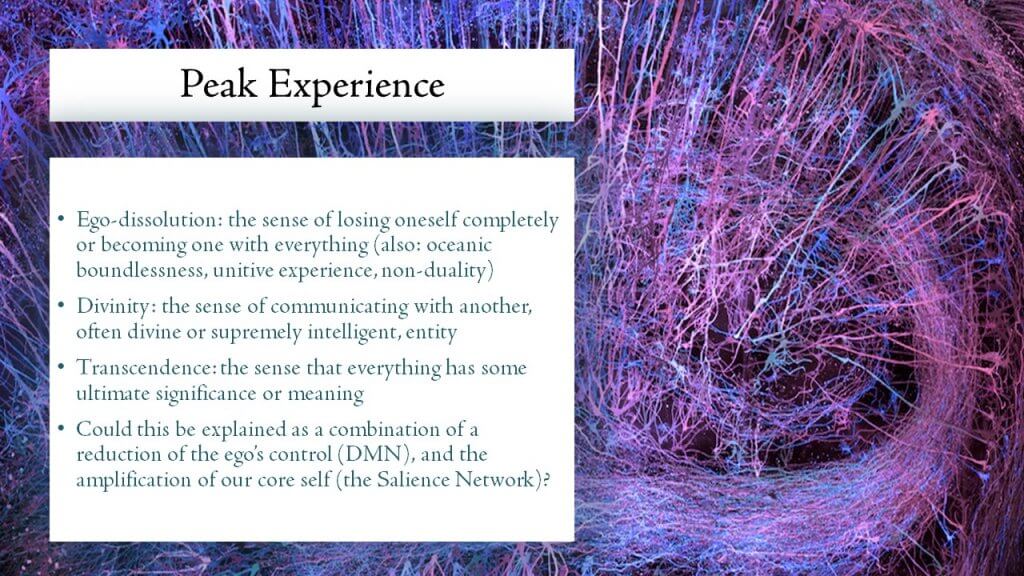
The peak experience has clinical value through enhancing neural plasticity. This has been reported in several studies. In the same way that a blacksmith heats up metal to make it more malleable, psychedelics could increase the excitability of the brain to make it more plastic.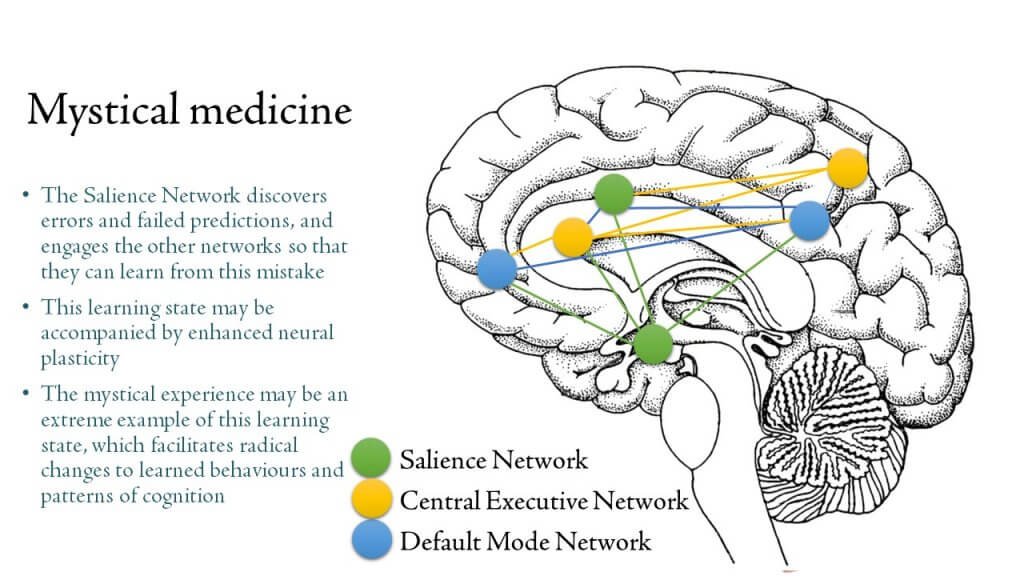
- The Salience network helps us adapt our behaviour. When we make a mistake or a failed prediction, the Salience network draws our attention to the issues, and increases the plasticity of relevant brain areas so we can learn from our mistakes, and adapt.
- The greater the mistake, the higher the salience, and the greater the plasticity
- The mystical experience could be the extreme example of this state. We experience the highest level of significance and are able to change in the most profound ways
- The mystical experience can also happen endogenously, without drugs, usually during moments of extreme stress, or in near-death experiences. These highly stressful or life-threatening situations can trigger dramatic shifts in behaviour in the ultimate effort to survive.
- Psychedelic drugs can trigger this same deep-learning mechanism, but in a way that we can accurately harness, leading to extraordinary therapeutic opportunities.
- Psychedelics can induce a state of high plasticity, enabling profound shifts in thoughts and behaviour to be achieved, rapidly.
- The mystical aspect of this learning experience isn’t just incidental, but fundamental to its value.
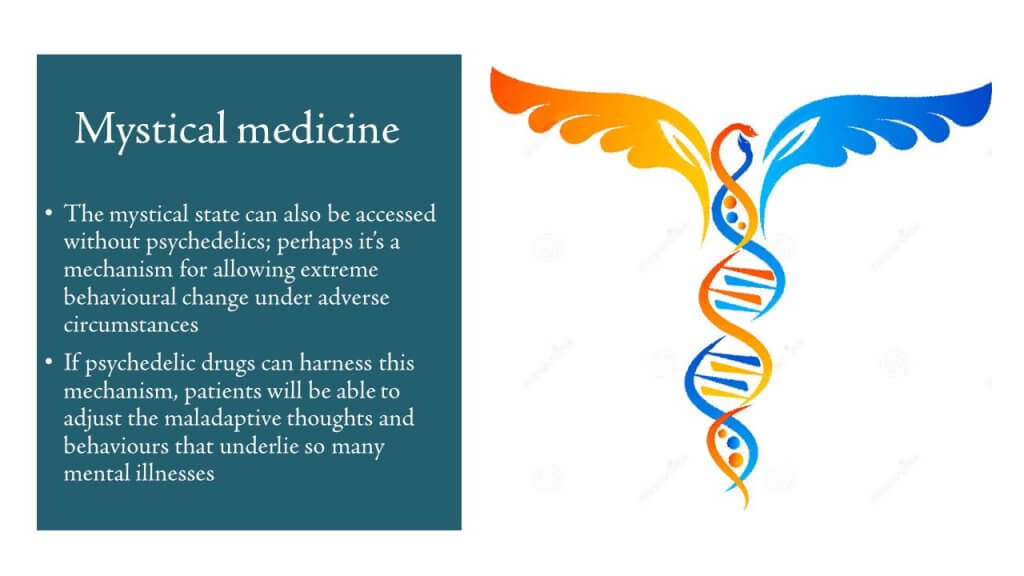
To conclude, our research is beginning to shed light on the psychedelic peak-experience and on how it can be so valuable in therapy.
Much less is known about the microdosing experience, but I hope in the next few years this will change dramatically, and that we will have a better understanding of how microdosing can benefit mental health and society. In fact, microdosing might prove to be a more palatable way to open the doors to psychedelic therapy.
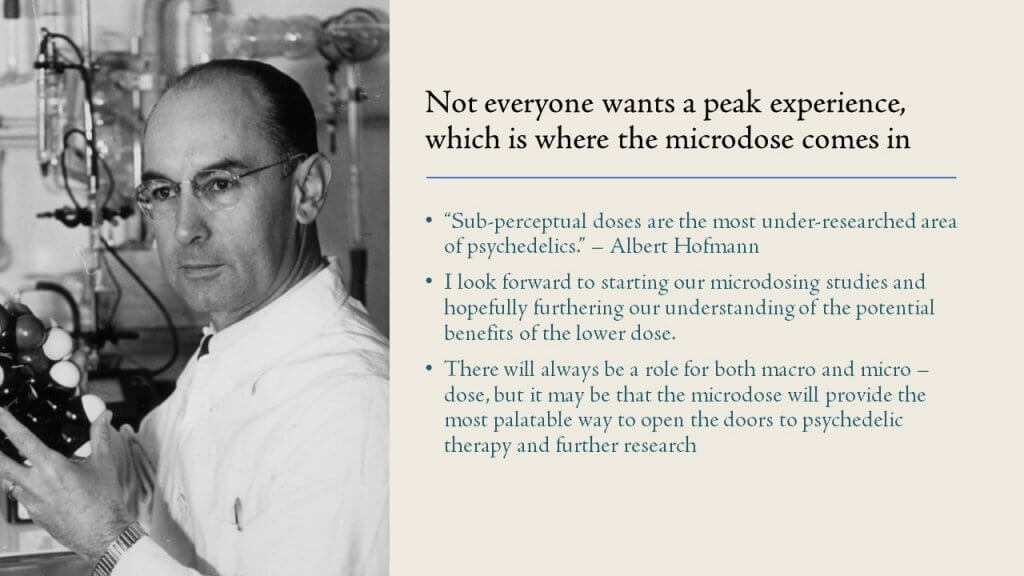
The past few years have been the most productive ever in terms of quality research into psychedelic medicine, and that trend only looks set to increase in the next few years. It is an exciting time! I am looking forward to finally getting answers to the questions I first asked fifty years ago, hopefully enabling these wondrous medicines to reach those in the greatest need.”
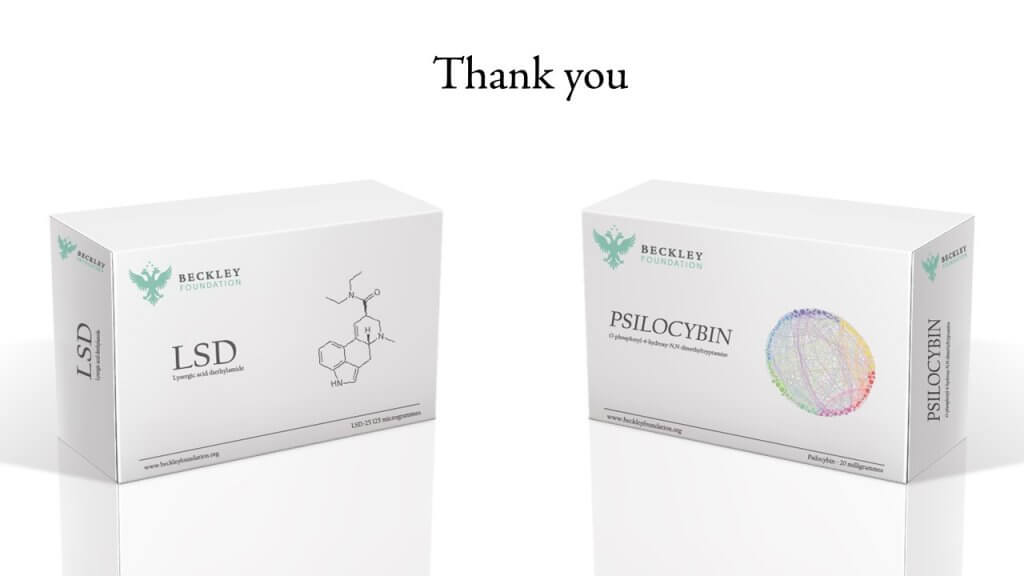
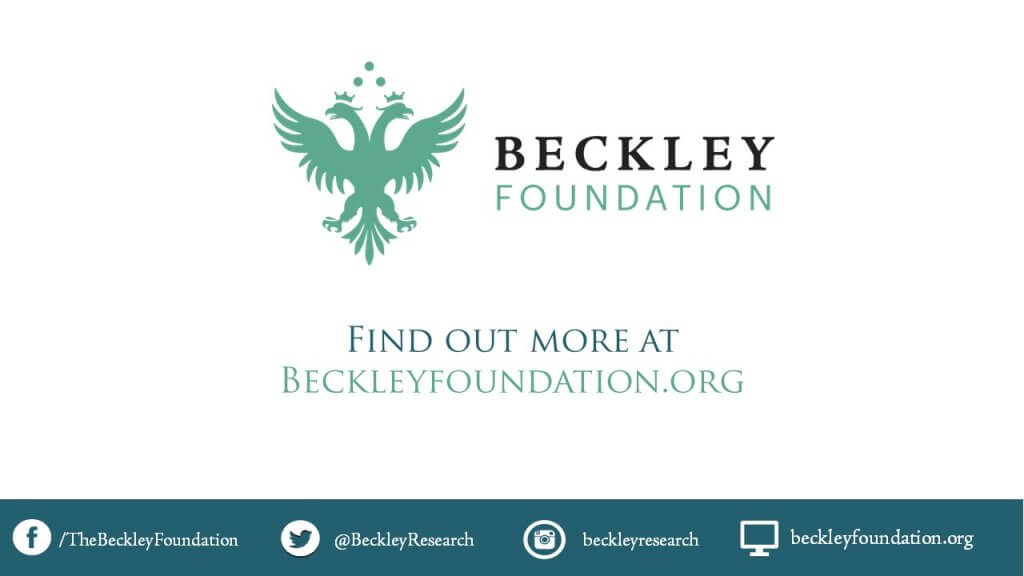
Podcast
- All
Links
- All
Support
- All
BIPRP
- All
Science Talk
- All
Amanda's Talks
- All
- Video Talk
- Featured
- 2016 Onwards
- 2011-2015
- 2010 and Earlier
- Science Talk
- Policy Talk
One-pager
- All
Music
- All
Amanda Feilding
- All
Events
- All
Highlights
- All
Psilocybin for Depression
- All
Current
- All
Category
- All
- Science
- Policy
- Culture
Substance/Method
- All
- Opiates
- Novel Psychoactive Substances
- Meditation
- Trepanation
- LSD
- Psilocybin
- Cannabis/cannabinoids
- Ayahuasca/DMT
- Coca/Cocaine
- MDMA
Collaboration
- All
- Beckley/Brazil Research Programme
- Beckley/Maastricht Research Programme
- Exeter University
- ICEERS
- Beckley/Sant Pau Research Programme
- University College London
- New York University
- Cardiff University
- Madrid Computense University
- Ethnobotanicals Research Programme
- Freiburg University
- Medical Office for Psychiatry and Psychotherapy, Solothurn
- Beckley/Sechenov Institute Research programme
- Hannover Medical School
- Beckley/Imperial Research Programme
- King's College London
- Johns Hopkins University
Clinical Application
- All
- Depression
- Addictions
- Anxiety
- Psychosis
- PTSD
- Cancer
- Cluster Headaches
Policy Focus
- All
- Policy Reports
- Advisory Work
- Seminar Series
- Advocacy/Campaigns
Type of publication
- All
- Original research
- Report
- Review
- Opinion/Correspondence
- Book
- Book chapter
- Conference abstract
- Petition/campaign
Search type
